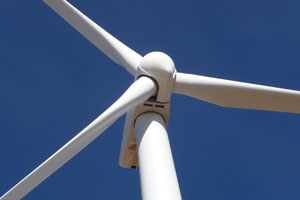BARR: You'd meet somebody and they'd ask you what you do for a living and you'd say, well I run a wind plant. What? And you'd explain the whole thing to them and they'd just "really?" you know. Today, everyone knows exactly what you're talking about.
SOMMER: That's because renewable energy has taken center stage in the state, especially for one particular elected official.
GOVERNOR ARNOLD SCHWARZENEGGER: When I took office the law, of course, required our utilities to deliver 20 percent of this renewable energy by the year 2017. And I said we can do better than that.
SOMMER: Three years ago, Governor Arnold Schwarzenegger shortened the timeline --committing utilities to get 20 percent of their electricity from renewables such as solar, geothermal, and wind, by the end of this year. It's an ambitious goal and now the question is: will we make it?
JULIE FITCH: Uhh, probably not.
SOMMER: Julie Fitch is the Energy Division Director for the California Public Utilities Commission, the agency overseeing the renewable goal.
FITCH: We'll get really close. We're projecting that by the end of this year, 2010, we'll be at about 18.5% and by 2011 that we'll be fully there.
SOMMER: Thanks to a three-year grace period, utilities won't be penalized for being a year or two late. But it does put them behind. That's because last fall, the governor set an even more aggressive goal— 33% renewable by 2020. According to Fitch's agency, given our growing need for energy, it will require an unprecedented effort— at least a doubling of transmission lines and a doubling of renewable energy.
TOM BOTTORFF: I think a lot of people have doubts about whether or not the utilities can do it. I'm in the camp that believes that it's feasible and doable and we're working very hard to make sure that happens.
SOMMER: Tom Bottorff is a Senior Vice President at PG&E, one of the utilities responsible for getting all that renewable power on the grid. He says the company has signed more than 100 contracts with solar, wind and geothermal developers.
BOTTORFF: But we're concerned whether all those projects that we've contracted with will actually come online. It's been a tough economy.
SOMMER: In most cases, it's up to developers to find the financing to build solar and wind farms, which has been hard to come by since the economic downturn. They've had some help recently from the federal stimulus funding.
BOTTORFF: That's been critical and we're very thankful that those opportunities are available.
SOMMER: Bottorff says the other challenge is California's complex permitting process. Since many solar and wind projects cover hundreds of acres in environmentally sensitive areas, developers must navigate local, state and federal agencies for permission to build, which can be a tricky process.
MICHAEL PICKER: I would probably describe it as painful, torturous and highly complicated.
SOMMER: Michael Picker is the Governor's Senior Advisor for Renewable Energy Facilities.
PICKER: The reality is that each one of the projects that we permit this year will immediately become the largest in the world. People are having to learn how to actually manage these projects through the pipeline.
SOMMER: Picker says the Governor's office is committed to speeding up the drawn-out permitting process, which will help put the 33% goal in reach. But even with the Governor's help, a number of major obstacles remain, like where to build new transmission lines and concerns about the impact of solar or wind farms on wildlife.
PETER MILLER: What we're trying to do is extremely ambitious in California.
SOMMER: Peter Miller is a Senior Scientist with the Natural Resources Defense Council, an environmental group in San Francisco. He says California's renewable standards aren't just about energy. For one, they're key to reaching the state's landmark global warming goal to cut greenhouse gases emissions a quarter by 2020. Their significance also goes beyond state borders.
MILLER: California has always been a leader on energy and environmental efforts and this, the RPS program, is no exception.
SOMMER: Over thirty states have renewable energy goals, though California's is one of the most aggressive. That means many states are watching how California's does— both its progress and its missteps.
For QUEST, I'm Lauren Sommer, KQED Radio News.
 From KQED Public Radio, I'm Andrea Kissack. This week, KQED's science and environmental initiatives, QUEST and Climate Watch, begin an occasional series: 33 by 20: California's Clean Energy Countdown.
From KQED Public Radio, I'm Andrea Kissack. This week, KQED's science and environmental initiatives, QUEST and Climate Watch, begin an occasional series: 33 by 20: California's Clean Energy Countdown.